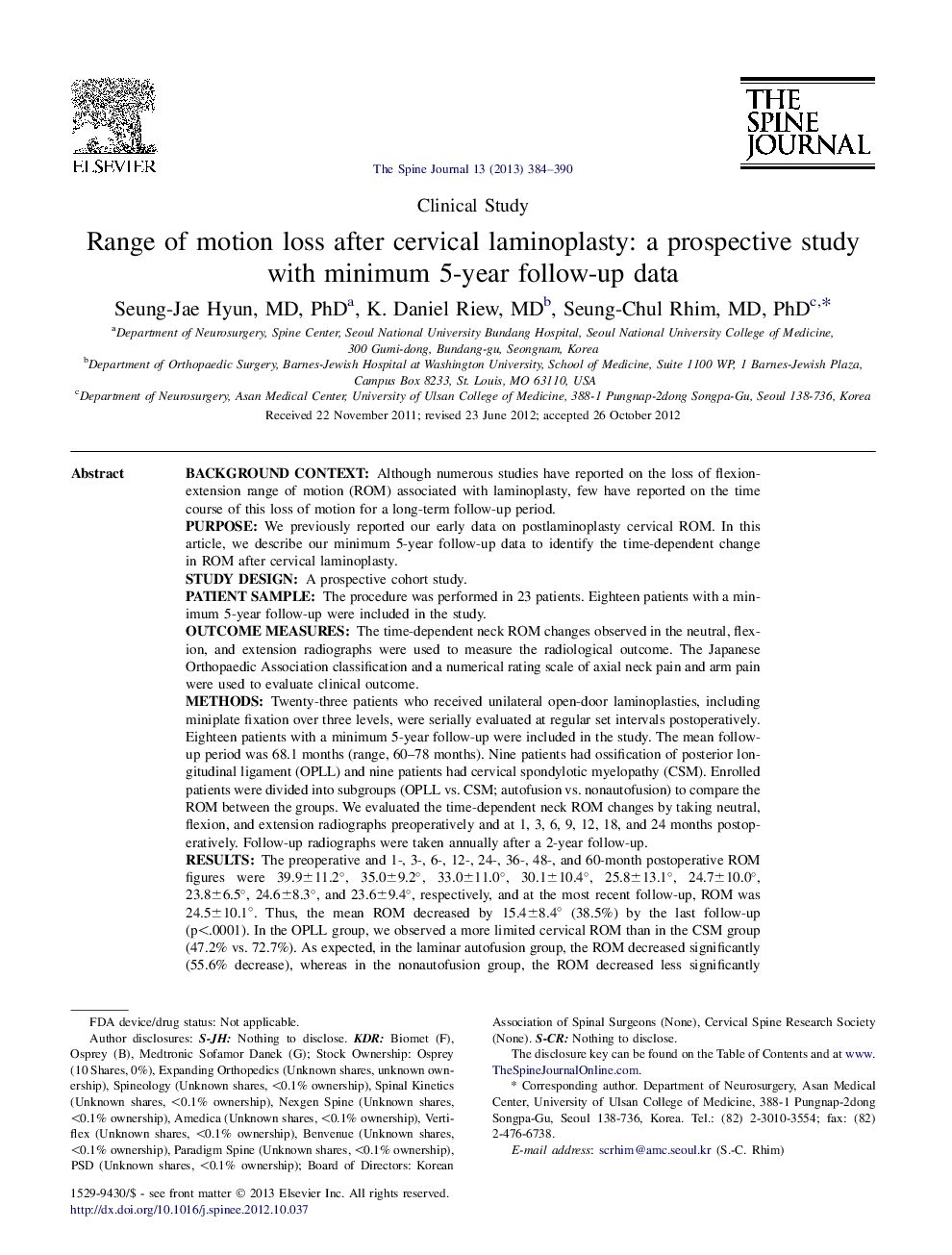| کد مقاله | کد نشریه | سال انتشار | مقاله انگلیسی | نسخه تمام متن |
|---|---|---|---|---|
| 6212662 | 1268587 | 2013 | 7 صفحه PDF | دانلود رایگان |
Background contextAlthough numerous studies have reported on the loss of flexion-extension range of motion (ROM) associated with laminoplasty, few have reported on the time course of this loss of motion for a long-term follow-up period.PurposeWe previously reported our early data on postlaminoplasty cervical ROM. In this article, we describe our minimum 5-year follow-up data to identify the time-dependent change in ROM after cervical laminoplasty.Study designA prospective cohort study.Patient sampleThe procedure was performed in 23 patients. Eighteen patients with a minimum 5-year follow-up were included in the study.Outcome measuresThe time-dependent neck ROM changes observed in the neutral, flexion, and extension radiographs were used to measure the radiological outcome. The Japanese Orthopaedic Association classification and a numerical rating scale of axial neck pain and arm pain were used to evaluate clinical outcome.MethodsTwenty-three patients who received unilateral open-door laminoplasties, including miniplate fixation over three levels, were serially evaluated at regular set intervals postoperatively. Eighteen patients with a minimum 5-year follow-up were included in the study. The mean follow-up period was 68.1 months (range, 60-78 months). Nine patients had ossification of posterior longitudinal ligament (OPLL) and nine patients had cervical spondylotic myelopathy (CSM). Enrolled patients were divided into subgroups (OPLL vs. CSM; autofusion vs. nonautofusion) to compare the ROM between the groups. We evaluated the time-dependent neck ROM changes by taking neutral, flexion, and extension radiographs preoperatively and at 1, 3, 6, 9, 12, 18, and 24 months postoperatively. Follow-up radiographs were taken annually after a 2-year follow-up.ResultsThe preoperative and 1-, 3-, 6-, 12-, 24-, 36-, 48-, and 60-month postoperative ROM figures were 39.9±11.2°, 35.0±9.2°, 33.0±11.0°, 30.1±10.4°, 25.8±13.1°, 24.7±10.0°, 23.8±6.5°, 24.6±8.3°, and 23.6±9.4°, respectively, and at the most recent follow-up, ROM was 24.5±10.1°. Thus, the mean ROM decreased by 15.4±8.4° (38.5%) by the last follow-up (p<.0001). In the OPLL group, we observed a more limited cervical ROM than in the CSM group (47.2% vs. 72.7%). As expected, in the laminar autofusion group, the ROM decreased significantly (55.6% decrease), whereas in the nonautofusion group, the ROM decreased less significantly (13.4% decrease) at the last follow-up. Postoperative axial pain did not correlate with the cervical ROM.ConclusionsThese results suggest that the loss of cervical ROM after laminoplasty is time-dependent, and patients with OPLL and laminar autofusion had less ROM. Postlaminoplasty ROM reduction can recover after several years, unless laminar autofusion occurs.
Journal: The Spine Journal - Volume 13, Issue 4, April 2013, Pages 384-390
